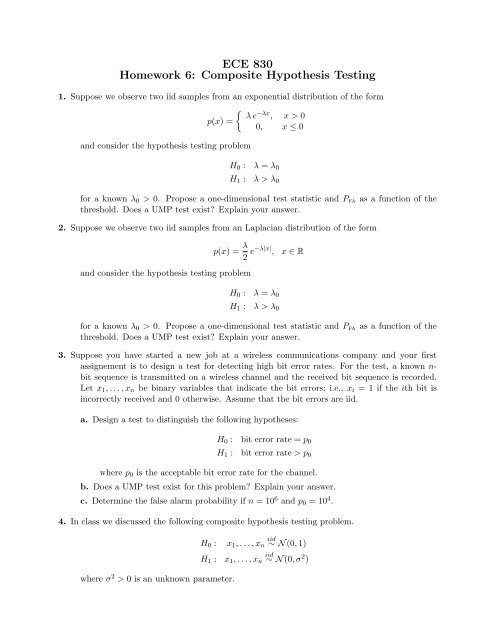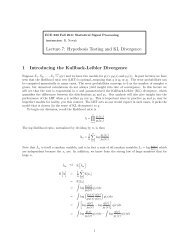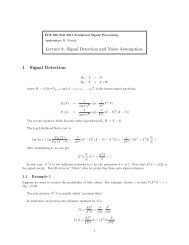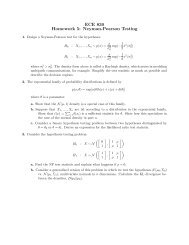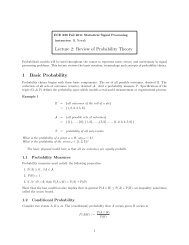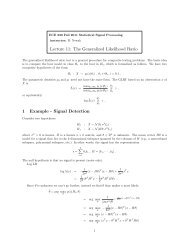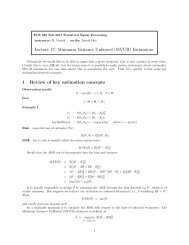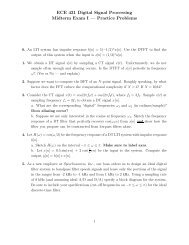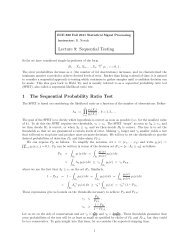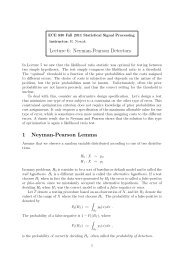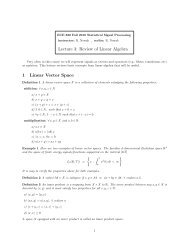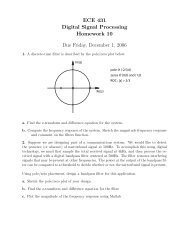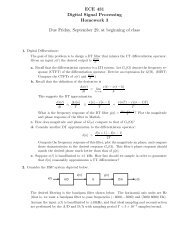ECE 830 Homework 6: Composite Hypothesis Testing
ECE 830 Homework 6: Composite Hypothesis Testing
ECE 830 Homework 6: Composite Hypothesis Testing
Create successful ePaper yourself
Turn your PDF publications into a flip-book with our unique Google optimized e-Paper software.
<strong>ECE</strong> <strong>830</strong><br />
<strong>Homework</strong> 6: <strong>Composite</strong> <strong>Hypothesis</strong> <strong>Testing</strong><br />
1. Suppose we observe two iid samples from an exponential distribution of the form<br />
{ λ e<br />
p(x) =<br />
−λx , x > 0<br />
0, x ≤ 0<br />
and consider the hypothesis testing problem<br />
H 0 : λ = λ 0<br />
H 1 : λ > λ 0<br />
for a known λ 0 > 0. Propose a one-dimensional test statistic and P FA<br />
threshold. Does a UMP test exist? Explain your answer.<br />
as a function of the<br />
2. Suppose we observe two iid samples from an Laplacian distribution of the form<br />
p(x) = λ 2 e−λ|x| ,<br />
x ∈ R<br />
and consider the hypothesis testing problem<br />
H 0 : λ = λ 0<br />
H 1 : λ > λ 0<br />
for a known λ 0 > 0. Propose a one-dimensional test statistic and P FA<br />
threshold. Does a UMP test exist? Explain your answer.<br />
as a function of the<br />
3. Suppose you have started a new job at a wireless communications company and your first<br />
assignement is to design a test for detecting high bit error rates. For the test, a known n-<br />
bit sequence is transmitted on a wireless channel and the received bit sequence is recorded.<br />
Let x 1 , . . . , x n be binary variables that indicate the bit errors; i.e., x i = 1 if the ith bit is<br />
incorrectly received and 0 otherwise. Assume that the bit errors are iid.<br />
a. Design a test to distinguish the following hypotheses:<br />
H 0 : bit error rate = p 0<br />
H 1 : bit error rate > p 0<br />
where p 0 is the acceptable bit error rate for the channel.<br />
b. Does a UMP test exist for this problem? Explain your answer.<br />
c. Determine the false alarm probability if n = 10 6 and p 0 = 10 4 .<br />
4. In class we discussed the following composite hypothesis testing problem.<br />
H 0 :<br />
H 1 :<br />
x 1 , . . . , x n<br />
iid<br />
∼ N (0, 1)<br />
x 1 , . . . , x n<br />
iid<br />
∼ N (0, σ 2 )<br />
where σ 2 > 0 is an unknown parameter.
a. Design a GLRT for this problem.<br />
b. Apply Wilks’ Theorem to choose a threshold for a test with false-alarm probability of<br />
0.05.<br />
c. Simulate the detection problem with n = 30 in Matlab. Generate T = 1000 independent<br />
trials of the problem with H 0 true in half of the trials. Check whether the empircal falsealarm<br />
rate of the GLRT is close to the desired level of 0.05. If not, try a larger value<br />
for n in your simulation. Plot the (empirical) distribution of the log GLR test statistic<br />
when H 0 is true. Compare it to the asymptotic distribution of the statistic (according to<br />
Wilks Theorem). Is the asymptotic distribution close to the observed distribution (i.e.,<br />
is n = 30 large enough)?<br />
d. Design a GLRT with P F A = 0.05 for a slightly different set of hypotheses:<br />
H 0 :<br />
H 1 :<br />
x 1 , . . . , x n<br />
iid<br />
∼ N (0, σ 2 )<br />
x 1 , . . . , x n<br />
iid<br />
∼ N (µ, σ 2 )<br />
where both σ 2 and µ are unknown.


